On Thursday I attended a cattle show and auction, ate bollito misto in a heated tent with hundreds of locals, and strolled a town-wide market where vendors hawked everything from porchetta to tractors — all before 11:30 AM.
I was at la Fiera del Bue Grasso (the Fair of the Fat Ox) in Carrù, a small town about 30 minutes away from Bra. This was the 102nd edition of the Bue Grasso, and it is a day of great tradition and pride for local breeders who raise Piedmontese cattle, which are known for their high quality lean beef. Farmers bring their best oxen, cows, and calves to Bue Grasso to compete for the best-of-the-best in category. The cattle are judged by a group of veterinarians, technicians, butchers, and breeders, and the winners are adorned with caparisons (ornamental saddle-coverings) and are awarded gold medals, plaques, certificates, etc. After the awards, butchers bid on the cattle of their choice, paying around 12 euro a kilo for the live animal, which works out to more than 14,000 euro for some of the bigger oxen. It’s sort of like the Westminster dog show, but with less prancing, more men, and an auction at the end.
Spectating at Bue Grasso is a bit strange — I felt more like a sociologist taking field notes than a visitor participating in a traditional festival. After the cattle are marched into town in the wee hours of the morning (we chose to drive to Carrù at 7:30 AM instead of 5 AM, so we didn’t see this), they spend the day in the exhibition pen, being examined by the team of judges. The cattle were very stressed out — many had their eyes covered with feed bags, and a few were butting their heads against the barricade. Last year, the ox that won the top award at Bue Grasso lost 70 kilo over the course of the festival day, due to stress (for perspective, that ox weighed 1,350 kilo, or almost 3,000 lbs). On the face of it, this event goes against one of the principles of Slow Food: fair. The exhibition pen didn’t exactly embody the fair treatment of animals.
However, Carlo Petrini, the founder of Slow Food, attended Bue Grasso himself, and it was recommended to University students as a must-go festival. The administration even agreed to shuffle our class schedule around so that my Master class could attend Bue Grasso in the morning. I believe that Bue Grasso is so respected because the aim of the festival is to promote the breeding of Piedmontese cattle, and the consumption of their top-quality beef, which falls nicely in line with the Slow Food promoting traditional, regional, quality products. Which brings me to the other important component of Bue Grasso — bollito misto.
Bollito misto is a traditional Italian dish similar to the French beef stew pot-au-feu. Essentially, it is a way to cook the tougher parts of the cow; in Piedmont, bollito typically includes cuts like tongue, cheek, and shoulder. It is served with salsa verde — a thick mixture of chopped parsley, garlic, capers, anchovies, and olive oil. During Bue Grasso, practically every eating establishment in Carrù serves bollito di bue. We opted to eat in the Bollito No Stop tent because we wanted to get a community feel, and because after an hour of market strolling (Bue Grasso is a big market day in Carrù) and people-and-cattle-watching, we needed to go someplace warm. And so, at 9:30 AM, I ate boiled ox meat.
I split a bollito meal with my roommate Deb. I wasn’t brave enough to eat the gnarly piece of ox cheek we were served — too much fat and some creepy-crawly villi-looking bits. The shoulder, though, was quite tasty, especially when smeared with salsa verde. We washed it down with wine (Dolcetto di Dogliani), because even though it was breakfast time, it was about 25 degrees F out, and because at Bue Grasso, one must drink Dolcetto.
Here are some more outtakes from the day. We didn’t stay for the awards or passarella (catwalk of cows) because we had to make it back to school, but overall I got a good glimpse of a folklorish festival day in Piedmont!
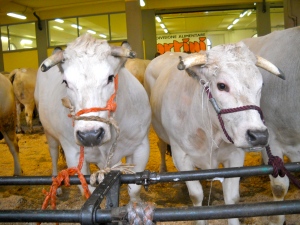
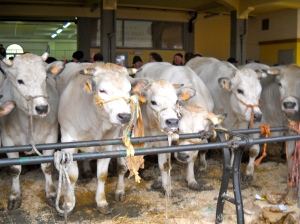
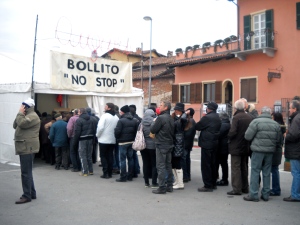


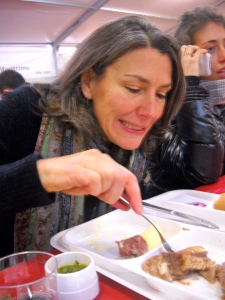
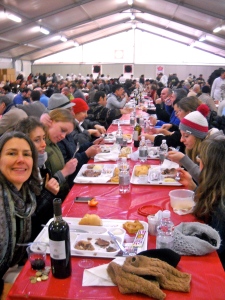
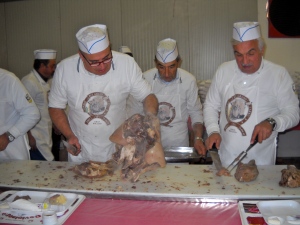
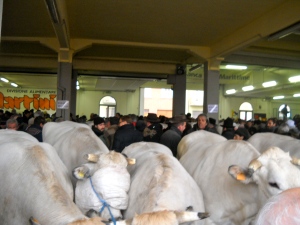
The issue of transporting cattle or any animal to an event like this is an interesting one for me. The whole point is to win a prize (or at least partake in the day) which means that you have to spend considerable time making sure your cow is happy, healthy, strong and generally low stress the rest of the year. This means a healthy diet, good living conditions and an attentive, caring farmer. I would argue that cattle that come to this, despite having a bad week, are probably very lucky to live on the farms that they do. This might not be offset by the extreme stress that would cause that much weight loss, but a strong tenant of raising animals is that they should have one bad day and the rest of their life should be as perfect as we can make it.
Thanks for the farmerly-input, Ellie! I was wondering what you would make of this festival, and hoping that the cattle at Bue Grasso had indeed been treated well for their lives on the farms, and that the stress of the day was just that–one bad day.